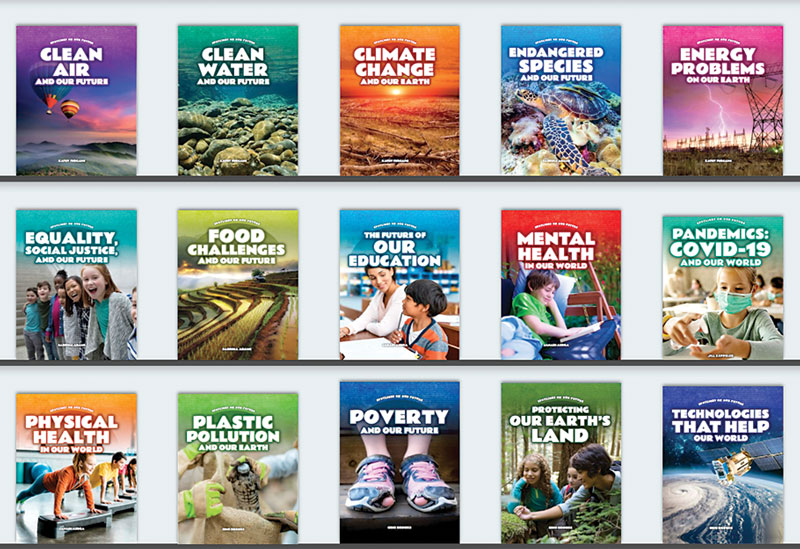Spotlight on Our Future | Reference Database Review
Rosen's series of enhanced ebooks focuses on ecological challenges, including air quality and plastic pollution, as well as social concerns such as education, mental and physical health, poverty, and the COVID-19 pandemic.

Rosen Digital Spolight on OUr Future
Grade Level Gr 4-8
Cost The 15 ebooks are listed at $1,124.25 for schools or libraries, a one-time cost including unlimited simultaneous access. Individual titles are available for $74.95 each.
Content This series of enhanced ebooks focuses on ecological challenges, including air quality and plastic pollution, as well as social concerns such as education, mental and physical health, poverty, and the COVID-19 pandemic. In addition to outlining the history and context of the various challenges, the books highlight young activists working on solutions and offer suggestions for getting involved.
When users log into the site, the ebooks appear arranged on a virtual shelf. When users select a title, the cover image is enlarged and centered, and a start button appears, along with buttons for full-screen mode and for returning to the bookshelf menu screen.
When users click “Start,” the book opens and basic content is displayed in a two-page panel that takes up much of the window. “Next page” and “previous page” buttons appear in the top corner of the book panel.
At the top of the page, users will find an interactive time line of key events, both more general ones and those specific to the topic. For example, in the ebook Pandemics: COVID-19 and Our World, events related to the pandemic appear with blue markers, while more general milestones appear in red.
An “Explore This Page” menu, on the left side of each page, links to a range of supplemental features, including vocabulary words (a pop-up window defines the word, explains how to pronounce it, and lets users click a button to hear the word spoken aloud). Every spread makes a new list of resources available
A “More About” section links to brief articles about related topics—for instance, Food Challenges and Our Future includes a piece about the Pure Food and Drug Act of 1906. Sometimes, the menu highlights links to primary source materials.
While the books are optimized for viewing on mobile devices, when viewed on a laptop the display defaults to desktop mode, where the text portion of the books is an image and cannot be copied and pasted for note-taking, though an entire spread may be downloaded as a JPEG file.
On mobile devices, the layout is more nested and compact, and text may be copied and pasted and individual illustrations downloaded. The configuration must be set from the bookshelf page and cannot be changed from within individual books, though it remains set until changed again.
On most pages, opposite the time line at the top there is a prominently displayed box with a discussion question, such as “Why was Brown v. Board of Education an important case?” A click opens up an answer within the box. This space is also sometimes occupied by an annotated map that may be enlarged.
A “listen” button at the top of each section of text starts a read-aloud. The voice sounds natural and moves at a relatively slow, conversational pace. There are no controls for adjusting the speed of the recording or for translating or downloading it.
Users can also opt for a book-only view that allows them to read the texts without the extra features, though the additional content appears by default.
Student and teacher resources The platform supports instant login from Classroom, Canvas, Schoology, Blackboard, and several other popular learning management systems. Each book opens with a unique URL and takes readers to the book’s cover page, which is convenient for posting in an LMS or email, though educators cannot link to individual pages.
The “Explore This Page” menu includes an “Instructional Support” section with links to graphic organizers, lesson plans, assessments, and activities.
At the bottom of every page is a small tool bar that expands when users hover the cursor over it. The tool bar includes links to a table of contents and index, as well as links to primary source and printable materials in the book. Another link opens up a window to let users scroll through the pages of the book.
Clicking a button opens a small window containing a citation, in MLA and APA formats, that may be copied and pasted into an external document. Clicking the “credits” button displays photo and video credits, along with a copyright statement. However, there are no source notes, bibliography, or suggestions for further reading. The lack of sourcing is occasionally compounded by vague writing and imprecise phrasing, such as “Some people believe” or “There are also concerns.”
Verdict Reasonably priced, intuitive, and rich in content, the electronic texts in Rosen’s Spotlight on Our Future are an excellent supplement for elementary classroom instruction and assigned reading; they also offer support for lesson planning and assessment. Considering the absence of sourcing, however, they are less useful for formal research.
Bob Hassett, Luther Jackson M.S., Falls Church, VA
RELATED
The job outlook in 2030: Librarians will be in demand
The job outlook in 2030: Librarians will be in demand
ALREADY A SUBSCRIBER? LOG IN
We are currently offering this content for free. Sign up now to activate your personal profile, where you can save articles for future viewing





Add Comment :-
Be the first reader to comment.
Comment Policy:
Comment should not be empty !!!